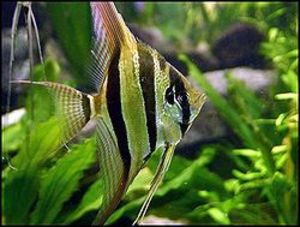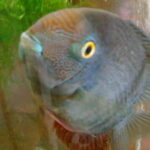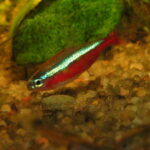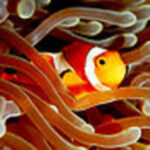Angelfish (or angel fish) are aquarium favorites for their beauty, feisty attitudes and good appetites. Unlike many other kinds of wet pets, angel fish can often easily adapt to many different kinds of foods. Although there are saltwater angel fish available in the pet trade, they are for experienced hobbyists only. The most common and hardiest kinds of angelfish available are freshwater angel fish.
What Is An Angelfish?
Freshwater angelfish are in a different genus than saltwater (or marine) angelfish. They are in a very large family of fish known as cichlids, which includes other large, pugnacious fish such as Oscars, the discus and the Jack Dempsy. They usually live in warm waters in Central and South America and often carnivorous.
Angelfish are best known by their triangular bodies, with a distinctive thin fin above and below them. When they turn in profile, the angel fish do vaguely take on the shape of a wing. Over the decades, the many varieties of angelfish found in the wild have been bred to make even more spectacular fish. Even though they vary considerably in size and color, they all are the same in that they do best on a varied diet.
On The Menu
Angelfish can live on just one kind of food, but they won’t thrive. Just as we need to eat a variety of foods to get all of the nutrients we need as well as to relive boredom so do pet fish. You need to select a basic food and alternative treats.
Good basic food is a floating pellet or flake food. Some hobbyists prefer the pellets, because they aren’t eaten as quickly as the flakes. Pellets can make the fish expend more energy in order to eat the harder substance. But you need to be sure your angelfish is large enough to eat pellet food. You can also alternate every day between pellets and flakes to keep your fish happy.
Insects that angelfish like to eat can be found in pet stores and aquarium supply shops as well. They can freeze dried, frozen or fresh. These include brine shrimp, bloodworms, tubifex worms and mosquito larvae. Many fish care books will also suggest feeder guppies, but those guppies can transmit diseases to your prized wet pets. However, if your angelfish has suddenly lost his appetite for the usual foods, then a baby guppy or a finely chopped piece of chicken may tempt him to eat again.
Angelfish Fry
Baby angelfish (fry) are so tiny that they can’t eat many of the commercially available foods. Fortunately, there are commercial fry foods now on the market. Some breeders have been able to make their own angelfish fry food by crushing flakes into powder small enough for the fry to eat. Newly hatched brine shrimp is also a great treat for them, but you may have to keep up a separate small tank in order to grow the brine shrimp from eggs.
References:
“Freshwater Aquariums For Dummies, Second Edition.” Maddy Hargrove & Mic Hargrove. Wiley Publishing; 2006.
Aquaworld Aquarium. “Spawning and Raising Angelfish.” http://www.aquaworldaquarium.com/Articles/TonyGriffitts/Spawning_and_Raising_Angelfish.htm
FishLore.com. “Angelfish (Pterophyllum scalare.)” http://www.fishlore.com/Profiles-Angelfish.htm
Personal experience.









